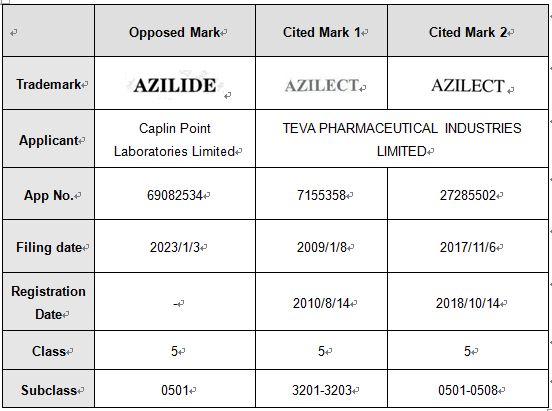Abstract
We, Kangxin Partners, P.C., on behalf of client, TEVA PHARMACEUTICAL INDUSTRIES LIMITED, filed an opposition action against the trademark AZILIDE under application No. 69082534 in Class 5 (thereafter referred as "opposed trademark") and the National Intellectual Property Administration, PRC ("CNIPA") subsequently examined the case and decided to reject the opposed trademark for registration.
Background
TEVA Group is a global pharmaceutical leader with over 120-year rich history. Today, TEVA's global network of capabilities enables its 37,000 employees across 60 global markets to push the boundaries of scientific innovation and deliver quality medicines to help improve health outcomes of nearly 200 million people across six continents every day. TEVA's leadership in healthcare has been trademarked by tenacity, entrepreneurial spirit, and an aspiration to improve people's lives. This defines how TEVA does business and motivates thousands of TEVA employees all over the world, every single day. Upon finding the opposed trademark, the client believed that it was similar to their prior registered trademarks, so that they entrusted us to file an opposition action against it.
The comparison of the trademarks is as below:

Summary of the case
In this opposition case, we mainly argued that:
1) The opposed trademark is similar to the cited trademark an both parties' goods are similar according to Chinese Classification of Goods and Services, thus, the opposed trademark and cited trademark constitute "similar trademark over similar goods", in violation of Article 30 of China Trademark Law.
2) Given the high reputation of the client and their trademarks, use and registration of the opposed trademark may easily lead to confusion and misunderstanding amongst relevant consumers regarding the resource and quality of the goods.
3) The opposed party filed the trademarks is not for use intention, in violation of principle of good faith of Articles7 & 8 as well as Articles 4 and 44.1.
The CNIPA made an opposition decision on January 15, 2024: the opposed trademark is similar to the cited trademarks, and both parties' goods are same or similar with respect to functions, usage and sales channels. Thus, as per Article 30 of China Trademark Law, the opposed trademark should not be approved for registration given it constitutes a "similar trademark over similar goods" with the cited trademarks.
Key Point of the Case
The key point of this case is that 1) the opposed trademark and cited trademarks constitute "similar trademark" and 2) The goods of the opposed trademark are similar to those of the cited trademarks.
According to the Guidelines for Trademark Examination and Trial, the factors to be considered for trademark confusion and misunderstanding include: the degree of similarity of goods or services, the degree of similarity between the trademarks of both parties, the distinctiveness and reputation of prior trademarks, etc.
With regard to Point 1, we argued from below aspects:
1) The opposed trademark and cited trademarks are similar in respect of the composed letters, pronunciation and overall appearance and we detailed analysis below.
² In term of composed letters and overall appearance, the opposed trademark is comprised of seven letters, A-Z-I-L-I-D-E and the cited trademarks are also comprised of seven letters, A-Z-I-L-E-C-T. The both parties' trademarks are all share the letters "AZIL*E* ", and first four letters are all same. For the English trademarks comprising of over 4 letters, the first few letters play an important role in distinguishing trademarks. We further emphasized that the composition and order of the first four letters of the opposed trademarks and the cited trademarks are completely identical, making it difficult for relevant consumers to distinguish the two trademarks amongst the public. Therefore, the both parties' trademarks are similar.
² In terms of pronunciation, the pronunciation of the opposed trademark is [a: zilled], and the pronunciation of "AZILECT" in the cited trademark is [a: zilekt]. The main syllable part [a: zille] of the two trademarks is exactly the same, while the subtle difference between the light consonants [d] and [kt] in the ending part makes it difficult for relevant consumers to distinguish them from the pronunciation.
2) The client's cited trademarks "AZILECT" has no specific meaning, therefore, it has strong distinctiveness and originality. According to the Opinion of the Supreme People's Court, when determining trademarks similarity, the distinctiveness and originality acquired by the trademark should be taken into consideration. The cited trademarks have acquired strong distinctiveness and originality, and this fact should be fully considered when judging the similarity and possibility of confusion and misunderstanding between the opposed trademark and the cited trademarks.
3) We presented prior similar precedents to prove that the CNIPA should also apply same criteria in this opposition case.
4) We further submitted the use evidence regarding the client's cited trademarks as evidence to prove the high reputation of the client's trademarks amongst relevant public.
All of the aforesaid facts and evidence can prove that coexistence of the trademarks is likely to lead the public to believe there is a relationship between both parties, so could potentially mislead them in respect to products' source and quality. With above efforts, we successfully convinced the examiner that both parties' trademarks are confusingly similar.
With regard to Point 2, we argued that the goods of the opposed trademark are similar to those of the cited trademark in accordance with the Chinese Classification of Goods and Services.
Conclusion
In the opposition cases, if the opponent has an earlier trademark right, Article 30 will be much important in the opposition cases. It is very important for the trademark attorney to make a thorough analysis of similarity of both parties' trademarks, and present strong evidence, such as prior similar precedents, materials showing high reputation of the cited trademarks to prove that they constitute "similar trademark". If we could successfully convince the examiner that both parties' trademarks are similar, then we could win the cases.
The content of this article is intended to provide a general guide to the subject matter. Specialist advice should be sought about your specific circumstances.

